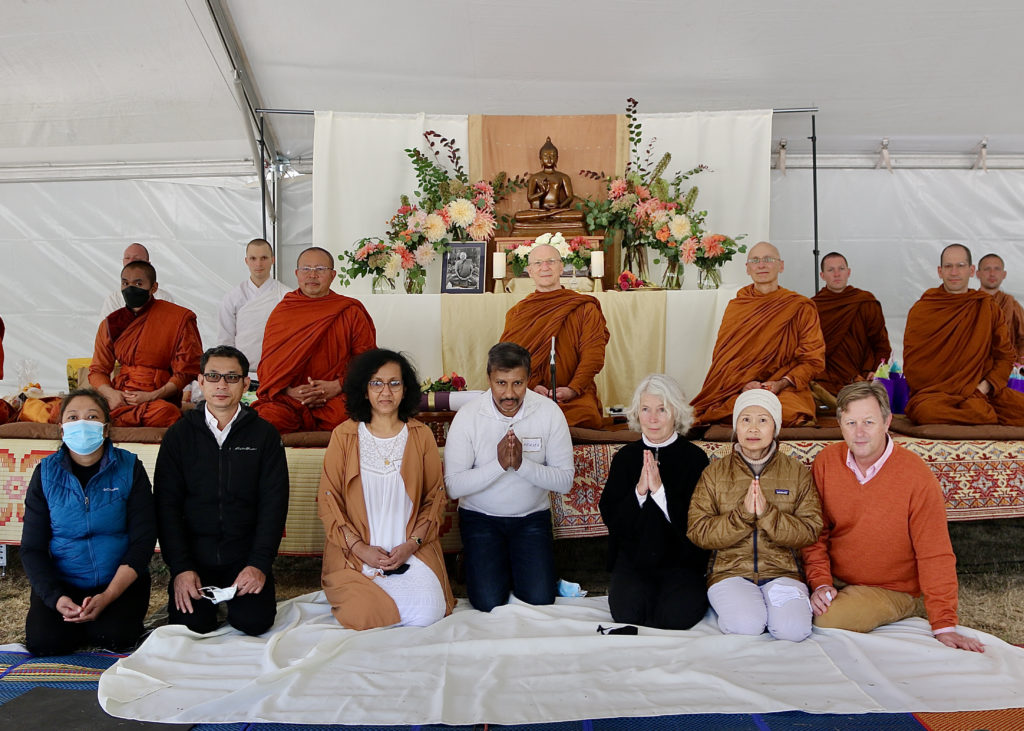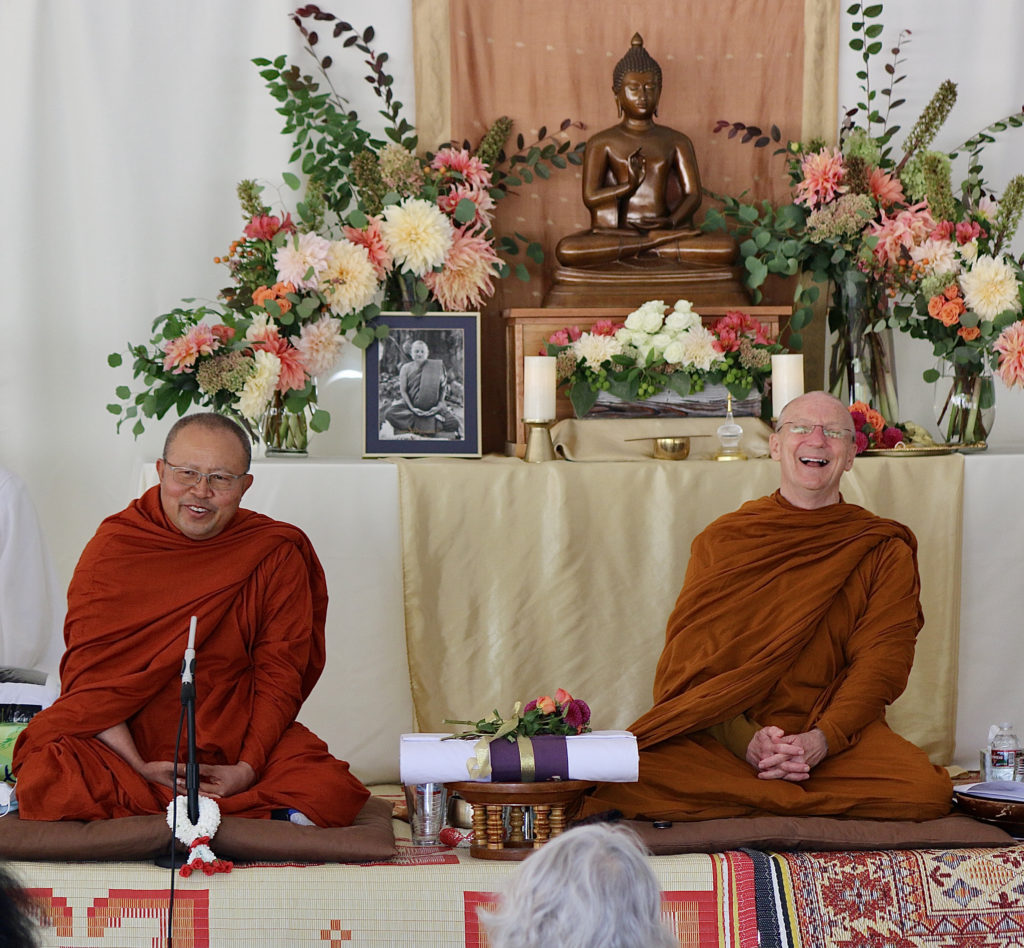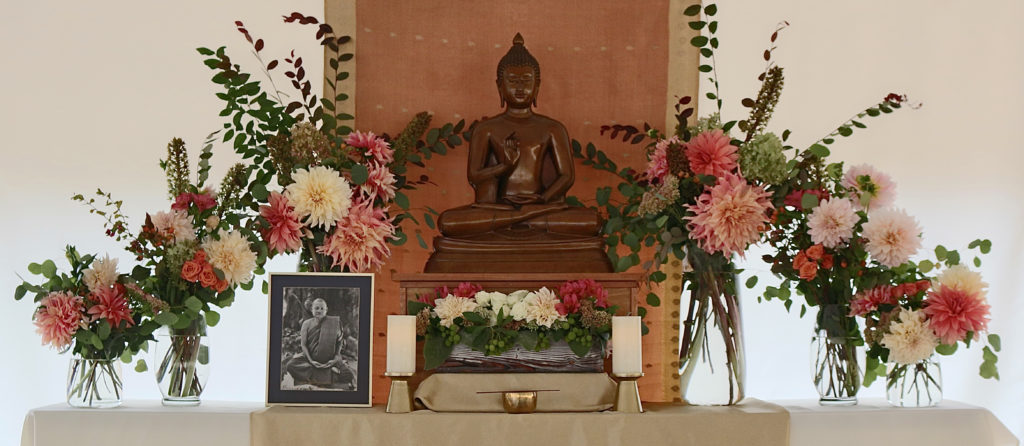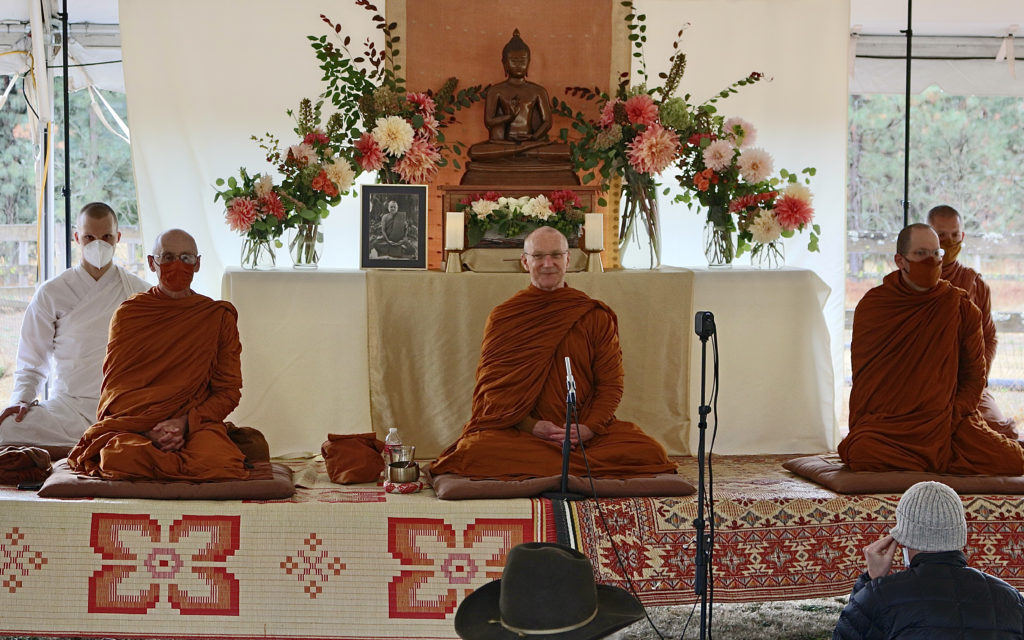Comings & Goings
With the end of the Vassa approaching, Luang Por Pasanno, Ajahn Karunadhammo, and Anagārika Ty will depart for Abhayagiri on October 25. The community is so grateful for their presence and sharing of Dhamma this summer!
Around December 1, Ajahn Kassapo, Ajahn Cunda, and Ajahn Ṭhitapañño, will arrive at the Hermitage, and stay through April 1. We look forward to welcoming them.
Ajahn Sudanto will be at the Hermitage on October 28 – 31, departing for Birken on November 1. Anyone who would like to stop by and say hello may do so on the weekend during the meal offering time (no visitors the 28th & 29th).
A Beautiful Pah Bah
It was a great joy that the (socially distanced & masked) Pah Bah could be held this year on September 18 & 19. In attendance were Luang Por Pasanno, Ajahn Karunadhammo, and Anagārika Ty, along with monks from Abhayagiri Monastery in California and from Atammayatarama Monastery in Woodinville, WA.
In this enduring tradition of celebrating the interdependence of monastics and the lay community, participants enjoyed a half-day of meditation on Saturday, with the meal offering and Pah Bah ceremony on Sunday. There was quite an outpouring of generosity from supporters near and far that will support the Hermitage plans for future land development and new Abbot’s kuti, anumodana!
Anumodana
This summer and fall, as always, have been filled with beautiful acts of generosity from the community. All those who worked diligently and with such care to create a beautiful Pah Bah, the sponsors, and those who participated. All who joined the Garden Parties to care for the land, and those who offered transportation. All who offered and coordinated meals, and other acts of generosity of all sorts.
Anumodana for all of these beautiful acts of generosity to support the Sangha, may they be of great benefit.
Connecting Online with the Sangha
With their return to Abhayagiri, this week is the last week to see Luang Por Pasanno and Ajahn Karunadhammo on the regular livestreams on the Pacific Hermitage YouTube Channel. Join them this week on Tuesday evening at 6:30 p.m. and Friday morning at 7:00 a.m. to hear the Dhamma.
Stay tuned for updates on future livestreams.
Luang Por Pasanno Reflects
[Excerpted from a Dhamma Talk by Luang Por Pasanno at the Pah Bah, September.19.21. To view in its entirety, began at about minute 50, here: The Pah Bah Ceremony ]
As I said in my pre-Dhamma talk, it’s about the choices we make. There’s a Dhammapada verse where the Buddha says to let one forsake a lesser happiness for a greater happiness. The wise person relinquishes the lesser in order to gain the greater happiness.
It’s a really important thing because the Buddha’s teaching, the central teaching, is of course is four noble truths: suffering, cause of suffering, end of suffering, path leading to the end of suffering. We’re hardwired to respond to happiness and suffering. And to be able to see what is difficult, what is unsatisfactory, what is leading to discontent – but also what is leading to happiness.
Of course we’re attracted to happiness, who isn’t? But to be able to make choices, and recognize that oftentimes we’re pulled to something that is tempting because it looks pleasurable, it looks fascinating, it looks exciting. It looks like – and it is going to give some kind of happiness. But is it a lesser happiness, or is there a greater happiness that we can be attending to? Because sometimes we get distracted by the lesser happiness and forget to recognize the opportunity that we have for greater happiness. And the refinement of goodness, the kind of steadiness that comes through having a determination, and then the skillfulness that comes by applying discernment and wisdom – that can lead to a greater happiness. And to be able to be cultivating and be reflecting on that.
Certainly, one of the things that the Buddha emphasized in his teaching is that everything is based on causal relationships. There is a cause and there is an effect. There’s a cause, there is a result. It’s not a direct one, it’s more like cause and condition, and then there is a result. It’s not linear, but there is a causal process. We have to pay attention to what causes are we putting in, and what result do we actually want. Because there are things that are of interest, grab our attention – but is it going to be fruitful? Is it going to be beneficial?
… When the Buddha taught and the four noble truths, it wasn’t just four noble truths, it was also the relationship or response to each of the truths that is really important. The first noble truth of dukkha, of suffering, is to be known, is to be understood. The second noble truth, the cause of suffering, is to be abandoned. Of course, we tend to just want to abandon the suffering, and then we forget to deal with the cause, so we keep doing it over and over again.
The third noble truth is the cessation of suffering, the ending of suffering. But the relationship is that it is to be realized, it’s to be made real. How do we make the ending of suffering, the experience of the non-rising of suffering, that letting go of suffering – how do we realize it? How do we live it? How do we experience it? And the last noble truth is the path leading to the end of suffering. That is to be cultivated, that’s to be developed.
So, we’ve got tools that we can be developing, we can be cultivating, we can be practicing with. There are just these basic practices of sīla, samādhi, paññā. Of virtue, of meditation, of wisdom and discernment – these are things we can do, and they have a result. There’s a cause and there’s a result, so that sense of making choices, and making skillful choices.
“One of the things the Buddha made very, very clear is that kamma is volition, is intention. It’s so important to recognize that we have the opportunity to take responsibility for our intention, where we place our minds.”
Luang Por Pasanno
